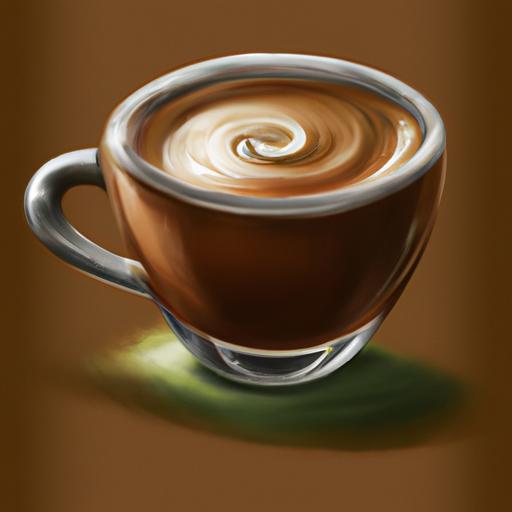From the aromatic smell, subtle flavor, and the unmistakable boost of energy, espresso has become a staple in coffee culture around the world.
But where did it come from? In this article, we’ll explore the origins of espresso, its popularity, brewing process, and how it differs from other types of coffee.
We’ll also look at some of the popular espresso-based drinks and espresso-making tips.
So lets start exploring the history, flavor, and alluring effects of espresso!.
Table of Contents
Short Answer
Espresso is a type of coffee drink that originated in Italy.
It is made by forcing hot, pressurized water through finely-ground coffee beans.
The result is a shot of concentrated coffee with a thick crema on top.
Espresso is usually served in a small cup and is used as the base for many other drinks such as cappuccino, latte, or macchiato.
The Origins of Espresso
The origins of espresso can be traced back to the late 19th century, when Italian inventor Angelo Moriondo created a machine that used steam to brew coffee.
This machine was the precursor to the modern espresso machine, which uses pressure to create a concentrated, flavorful cup of coffee.
Espresso soon became popular in Italy, and soon spread across the world, with espresso machines being used in cafes and restaurants.
The espresso has become a staple of the coffee-drinking experience, and is now enjoyed by coffee lovers everywhere.
The espresso is known for its intense flavor and robust aroma, which is created by the pressure used to force the water through the finely ground coffee beans.
This pressure creates a strong crema, which is a layer of foam on top of the espresso shot.
The crema adds a layer of flavor to the espresso, and is a sign of a good espresso shot.
The espresso is often served in smaller portions than other types of coffee, and is usually enjoyed in one shot.
This allows coffee lovers to enjoy a more intense coffee experience without having to drink an entire cup of coffee.
The espresso is also the base for many other coffee drinks, such as cappuccinos, lattes, macchiatos, and mochas.
These drinks are made by adding milk, flavorings, and other ingredients to the espresso.
The resulting drinks are often a favorite of coffee lovers, and can be found in many cafes and restaurants around the world.
Overall, espresso is a popular coffee drink around the world, and is known for its intense flavor and robust aroma.
It is usually served in smaller portions than other types of coffee, and is the base for many other coffee drinks.
The origins of espresso can be traced back to the late 19th century, when Italian inventor Angelo Moriondo created a machine that used steam to brew coffee, which was the precursor to modern espresso machines.
Espresso is enjoyed by coffee lovers everywhere, and can be found in many cafes and restaurants.
Espresso’s Popularity Around the World

Espresso is one of the most popular coffee beverages in the world.
Originally from Italy, it is enjoyed by coffee drinkers around the globe.
Its bold, intense flavor and high caffeine content give it an edge over other coffee drinks, and its smaller serving size helps to make it a favorite for those looking for a quick pick-me-up.
Espresso’s popularity has been steadily growing for decades, with many countries now having a booming espresso culture.
In the United States, for instance, espresso-based drinks such as lattes, cappuccinos, and macchiatos have become ubiquitous on menus of cafes, restaurants, and coffee shops.
Furthermore, the availability of espresso machines in homes has made it easier than ever to make espresso-based drinks in the comfort of one’s own home.
In Europe, espresso is the most popular way to consume coffee and is enjoyed in many forms.
From the classic Italian espresso to the more modern flat white, espresso drinks are deeply ingrained in the culture of the continent.
Even in countries such as the UK, where tea is the traditional hot beverage of choice, espresso-based drinks are becoming increasingly popular.
Beyond Europe and the United States, espresso is also popular in other parts of the world, such as South America, Australia, and Asia.
In many countries, espresso is seen as a luxury drink, with many cafes and coffee shops offering a variety of espresso-based drinks.
Espresso’s popularity is due in part to its bold flavor and intense caffeine kick, but also to its versatility.
Its small serving size makes it the perfect pick-me-up or afternoon pick-me-up, and its ability to be made into a variety of drinks gives coffee lovers a lot of options.
From lattes and cappuccinos to macchiatos and flat whites, there is an espresso-based drink for everyone!.
Espresso vs. Other Types of Coffee
When it comes to discussing the difference between espresso and other types of coffee, the most important factor is the way the coffee is brewed.
Espresso is made by forcing a small amount of nearly boiling water under pressure through finely ground coffee beans.
This process results in a more concentrated flavor and a higher caffeine content than other brewing methods.
The espresso shot is also usually served in a much smaller portion than other coffee drinks, ranging from one to two ounces.
In comparison, drip coffee is brewed by passing hot water through a filter containing ground coffee beans.
This method is much less concentrated and results in a milder flavor.
Drip coffee is also usually served in larger portions, ranging from 8 to 12 ounces.
Another difference between espresso and other coffee drinks is the type of coffee beans used.
Espresso is typically made with a blend of dark-roasted coffee beans that have been finely ground.
This allows for a higher extraction of flavor and a more intense taste.
On the other hand, drip coffee can be made with a wide variety of coffee beans, from light to dark roast, and can be coarsely or finely ground depending on the desired flavor.
The brewing time is also a factor that sets espresso apart from other types of coffee.
Espresso is brewed in only a few seconds, while drip coffee can take several minutes.
This faster brewing time allows for a more concentrated flavor and a higher caffeine content.
In conclusion, espresso is a unique type of coffee that is brewed in a very specific way.
It is made with a blend of dark-roasted coffee beans that have been finely ground, and it is brewed in only a few seconds.
This results in a higher concentration of flavor and a higher caffeine content than other types of coffee.
Espresso is usually served in smaller portions than other coffee drinks, and can be the base for many other coffee beverages.
Espresso Brewing Process

When it comes to the espresso brewing process, the key is to use hot water that is nearly boiling and to force it through finely ground coffee beans.
This produces a strong flavor and an intense caffeine kick that makes espresso so popular around the world.
The process starts by grinding coffee beans to a consistency that is slightly finer than other types of coffee.
This ensures that the flavor and aroma of the espresso is preserved.
The ground coffee is then placed in an espresso machine, where hot water is forced through with pressure.
The pressure helps extract more flavor from the coffee beans, as well as creating a thick, crema-like foam on top of the espresso.
The extraction process usually takes about 2030 seconds, and the result is a rich, flavorful espresso shot.
Espresso is usually served in smaller portions than other coffee beverages, and is enjoyed by coffee lovers everywhere.
Espresso’s Taste and Caffeine Content
Espresso is known for its strong flavor and intense caffeine kick, and for good reason.
Its unique brewing process, which uses hot water forced at a high pressure through finely ground coffee beans, allows more of the coffee’s flavor and caffeine to be extracted, resulting in a rich, full-bodied cup of coffee.
The brewing process also gives espresso its unique crema, a light layer of foam that sits atop the espresso and adds a creamy, velvety texture to the drink.
In terms of caffeine content, espresso packs quite a punch.
A single shot of espresso contains about 75mg of caffeine, which is around twice the amount found in a normal cup of coffee.
This makes espresso a great choice for those looking for a quick boost of energy, as the effects of the caffeine can be felt almost immediately.
The taste of espresso can vary depending on the type of beans used, the roast profile, and the brewing method.
Generally speaking, espresso can be described as having a bold, smoky flavor with slight sweet and bitter notes.
Depending on the roast profile, the flavor can range from a light, floral taste to a full-bodied, roasted taste.
Popular Espresso-Based Drinks

Espresso is the base for many delicious and popular coffee drinks enjoyed around the world.
One of the most popular espresso-based drinks is the cappuccino, which combines espresso, steamed milk, and foam.
The latte is also a popular espresso-based drink, which is made up of espresso, steamed milk, and usually a light layer of foam.
A macchiato is similar to a latte but with less milk and more foam.
An Americano is made with espresso and hot water, and has a milder flavor than other espresso-based drinks.
An affogato is a combination of espresso and ice cream, and a ristretto is an espresso shot with less water and a more concentrated flavor.
Espresso can also be used as a base for cold drinks such as the iced latte, iced mocha, and frappuccino.
No matter how it is served, espresso is a delicious and energizing drink that is loved by coffee lovers everywhere.
Espresso-Making Tips
When making espresso, the most important factor for success is the quality of the beans used.
Look for freshly roasted, high quality beans for the best results.
For the perfect espresso, use finely ground coffee for a stronger flavor and smoother texture.
The grind should be finer than what you would use for other types of coffee.
Another important tip for espresso making is to use the right equipment.
To make espresso, you need an espresso machine that is capable of producing the pressure necessary to extract the flavor from the beans.
Most espresso machines will also have a portafilter to hold the coffee grounds and a steam wand to produce the hot water.
In addition to the right equipment, you also need to use the right technique.
To make the perfect espresso, you need to use the right amount of pressure and a precise extraction time.
Start by tamping down the coffee grounds to ensure they are evenly distributed and then slowly pull the shot until the espresso is a rich, dark brown color.
The extraction time should be between 20-30 seconds.
Finally, the temperature is key to making a great espresso.
The ideal temperature for espresso is between 195-205F, so make sure that your espresso machine is able to reach this range.
For a smoother espresso, use cold milk and a steaming pitcher that is pre-heated.
These tips will help you make the perfect espresso every time.
With the right equipment, technique, and temperature, you can make a delicious cup of espresso that will be sure to impress your guests.
Final Thoughts
From its humble beginnings in Italy, espresso has become a popular drink around the world.
Its unique brewing process and intense flavor sets it apart from other types of coffee, and its concentrated caffeine kick is a favorite among coffee lovers.
If you’re looking to make the perfect espresso, remember that the grind size, tamping, and water pressure all play a part in making the perfect cup.
Now that you know where espresso comes from and how to make it, why not give it a try?.

